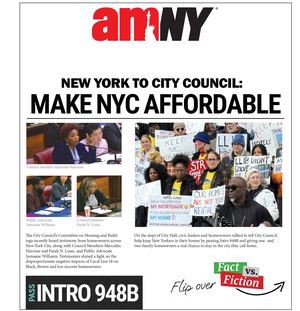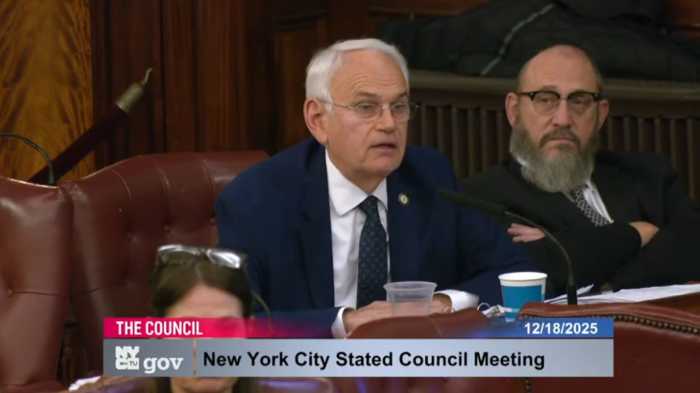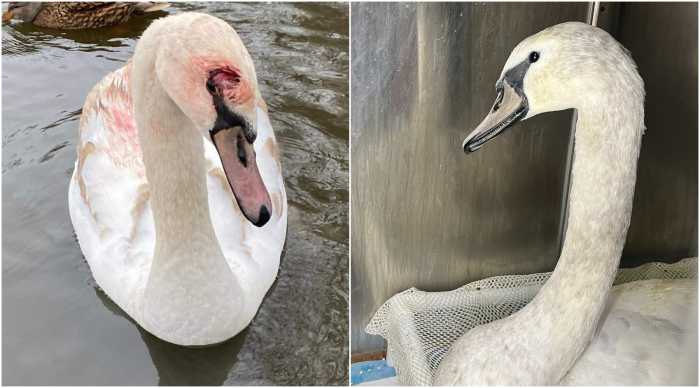Bill Willingham started writing the comic book “Fables” way back in 2002, bringing together figures from fairy tales, folklore and nursery rhymes for a smart, engrossing mystery series. He was joined by artist Mark Buckingham in the sixth issue, and the duo headed up a wonderful 13-year run that landed numerous awards, spin-off series, original graphic novels, a prose novel and a video game.
It was an impressive run that brought together familiar characters like Snow White, the Big Bad Wolf and Little Boy Blue into a unified world — New York City, in fact. The premise had the fabled characters fleeing the Homelands to a secret community in The Big Apple, shielded from regular humans by powerful magic. They also had an upstate New York spot, the Farm, where non-human characters like the Three Little Pigs could live safely.
The epic series comes to a heartfelt conclusion that will leave fans pleased and maybe just a little bit teary-eyed. The final issue, No. 150, is a massive finale, doubling also as the 22nd, and final, “Fables” graphic novel collection. It has a 78-page “Farewell” story as well as 21 short stories that bring closure to lives of some favorite “Fables” characters. The book is available on July 22.
amNewYork spoke with Willingham and Buckingham about the grand finale.
What are your emotions with “Fables” ending?
Bill Willingham: I think bittersweet is the most appropriate single term. It’s a sense of relief to have this done in the sense that “Fables” was getting really, really big and it seemed like every new script held more weight than the one preceding. But at the same time, there’s that sense of loss, like the first time you lose a tooth and there’s that sense that something’s missing and you can’t leave it alone. It feels odd not to wake up and work on “Fables” every day.
Mark Buckingham: I feel the same way. I’ve been missing all the team, working with everyone, and it’s been the focus of my life for the last 13 years. It’s really strange not to have a new script from Bill, to have a deadline for another bunch of pages from Shelly [Bond]; it’s very strange to have that absence. The only plus side, I guess, is that I’ve been operating as unofficial continuity cop on this for a big chunk of its run and storing mountains and mountains of useless information and character costumes, eye colors and all that good stuff in the back of my head for so long that I actually started to forget the names of members of my family or where I lived or things like that.
BW: Those aren’t important!
MB: I can finally do a major info dump and start to recall other aspects of life, which is kind of nice. But I do miss “Fables” immensely.
BW: What Mark is very politely saying is he was continuity cop because his partner is old and feeble-minded and could not remember all of the things one has to remember to keep this thing going.
What do you see as your greatest accomplishment with “Fables”?
BW: The 150-issue run is a pretty good accomplishment. We did it, for the most part, with the entire creative team intact, which is almost unheard of in comics. It’s rarely been done, and not just me and Mark working together, but me, Mark, Shelly, Steve Leialoha, Todd Klein — the core creative family of “Fables” — has managed to stay together and, like any family, there’s been squabbles. I could not have imagined this turning out this way at the beginning of “Fables.”
MB: When we started out, books would last for a year. You would expect, if you’re fortunate, if you don’t completely mess it up, that it will last a little while. But I think we never were fully prepared for the possibility that this would be a hit because I think that’s the funny thing, as a creator, you prepare yourself for the worst all the time and rarely kind of dare to believe that you created something wonderful. And it takes a while for people’s appreciation and praise to sink in to the point where you think,”we’ve actually come up with something good here.”
Any regrets?
BW: Only on every single page. [Laughs] Mark says this a lot and I disagree with him. He talks about his frustrations on how he’s not bowled over by his own art, and I just think it’s magnificent. It started magnificent and got better. But I can’t look at a page of “Fables” and still not see the things I wish I’d done a little more artfully, a little better. Yeah, tons of regrets.
MB: Yeah, but on the plus side, that always drove us to keep going and want to be better. So that was the driving force that kept us going. Not only the pleasure that we got from working together, but the fact that we really wanted to push ourselves to the limit and see what we could achieve.
BW: Sure. The worst think that I think can happen to any storyteller is to be satisfied with what he’s doing. Oh, that’s good enough.
After all these issues, do you have a favorite “Fables” character?
BW: For me, it’s the one that came as a surprise. Boy Blue is an example. He was never intended to be an important character. His sole purpose and creation was Snow White was going to be in the business office all the time — which turned out not to be the case — so she needs someone to talk to so she’s not babbling to herself. So we’ll just create this character for her to be speaking to when she explains her motivations or cares or concerns, etc. And for that reason, I didn’t use an important fairy tale character; I grabbed a character from a nursery rhyme. But then he surprised us by becoming important. And it was incremental. Why is he called Boy Blue? All we know about him is he dresses in blue, he blows his horn and there’s something about sheep and cows in the barn. That’s it. You inevitably ask the question: So he plays his horn, what kind of music does he play? The blues — he’s Boy Blue. Why would a kid like this play the blues? Well, there must be tragedy. What was the tragedy in his life? It snowballs from there until he became this big, huge character in this series. And he probably shares a place with King Ambrose — Flycatcher — as the good soul of the series. So yeah, he’s a favorite. And he died well. He died in a way that he knew was coming for a long time. He had time to adjust himself to it and he had a moment where he got to speak his mind before he went, which I think is a good thing.
MB: Blue was a favorite of mine as well. King Ambrose is always my sort of No. 1 favorite, of the human characters in “Fables.” I should qualify the fact that I secretly have more affection for the animals than the people in the series. That’s what attracted me in the first place. And the Farm was definitely the bit of “Fables” that I made my own and made my stamp on early on. So yeah, Flycatcher was the character I always adored. He was the character I could identify most wit — the one true innocent character in the series. From the female cast, it was Rose Red. That’s because I very quickly started adopting the look of my wife to the way that I drew Red, so the two became immediately intertwined.
How has “Fables” changed you as creators?
MB: I have the Mister Fantastic big streaks of grey down the side, I weigh a few more pounds than I used to, my back’s aching quite a bit these days. Oh, you actually wanted to know other aspects? [Laughs] It’s been a wonderful experience because it’s given me a major work that I could absolutely invest my heart and soul in and I could do it with the confidence that it was a series that readers love. And [I worked] with a group of fellow creators who were the best, most charming, most wonderful, talented people you could ever ask to be united with. It just gave me a focus and a purpose greater than I ever had before in my career. And I took such joy in the subject matter as well. With “Fables,” I think Bill inadvertently created the book I was waiting to draw, and foolishly let me on board and I refused to leave for 13 years.
BW: He did basically tell us he’s staying on the series. The initial template was artists would come on for one arc each, because that’s the way things were done at that time. Artists didn’t stay on a book for every long. The idea that I could get Buckingham for one story arc was amazing. And the fact that he wanted to stay, to this day I still don’t believe it. It changed in many ways perhaps how comics were done. Several times I’ve been approached by different artists who said, “I wish I had a home book like Mark Buckingham has in my career.” I have the additional gray hairs. I am comfortable in the sense that since “Fables” started, for the first time in my career that I haven’t had a month wondering if I could make rent this month. But the best thing, for the last 13 years, with few exceptions, a few frustrations and minor quibbles, I got to tell the story I wanted to tell every month for 13 years. It took me a while in my career to realize I shouldn’t waste my time doing stories I’m not enthused to tell. But sometimes you just take jobs to take jobs.
Do you think you’ll ever return to the world of “Fables”?
BW: Mark has a better version of this answer, but the answer is: No firm plans, but never say never. Even as careful as we were to answer all the big questions we could, there’s a wealth of unanswered questions and story possibilities left behind. So I would never say absolutely not.
MB: But we want to nap!
BW: [Laughs] I said Mark had a better answer. That’s what it was.
Any word on the potential “Fables” movie?
BW: Not really. Not to be coy. I pretend that I’m much more in the loop on that, but my understanding is it’s still a go, in the sense that they still intend to make one, but they haven’t had a lot of luck in producing a movie script that is satisfactory to the people that make those decisions.
What’s next?
MB: I’ve got some laundry to do. I have been very fortunate that I’ve come off a series that is the longest I’ve ever worked on for 13 years with one of the nicest people in comics, to then go off and work on another book that also I have a long association with, with one of the other nicest people in comics, because I’m having “Miracleman” with Neil Gaiman again after a 22-year hiatus. So for my next year and a half, I’m going to be focused on that book.
BW: I’ve got a chart in my writing room. It’s called Project 13 because there’re 13 shorter stories I’m going to do — short run comic series, finishing some novels, some short stories I have in mind. And I have to get all 13 of them done. When I’m done with those, then I can consider a longer work again. And it says on the chart no more than 20 issues per project, and that’s the absolute. The most recent time [update to] the chart is for a script for a nine-page comic short story. I just handed that in. That’s the size I’m looking for for a while, just to not take on another 150-issue epic any time soon again.
MB: I have to agree with Bill. I just wrote an eight-page story myself for Vertigo, and just the pleasure of being able to start and finish something in the same day — that’s it! It’s done! It’s a nice change of pace from being involved in something for half my career, as is the case with “Fables”
Bill, you did a short story for “Fables” 150. Any chance you’ll be drawing more?
BW: Yes. I am a slow artist. I might be the world’s slowest artist. So, small things here and there; there is a possibility.




































